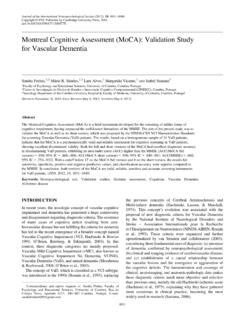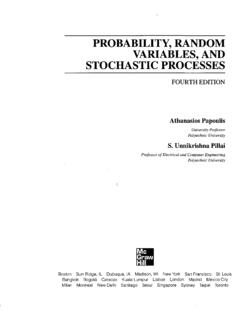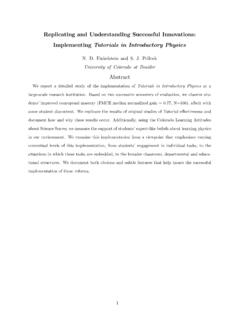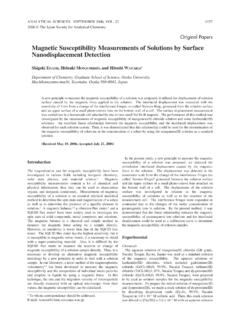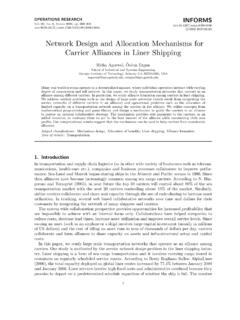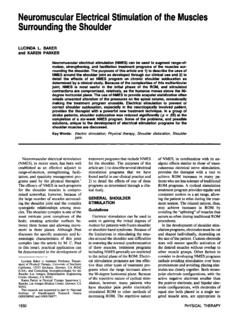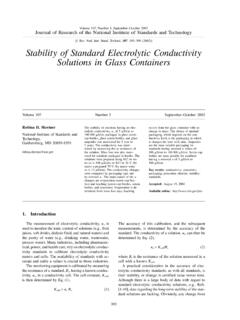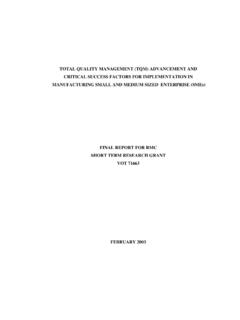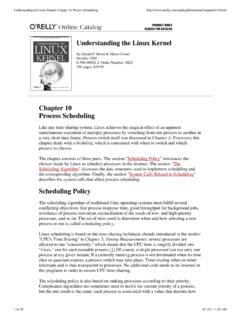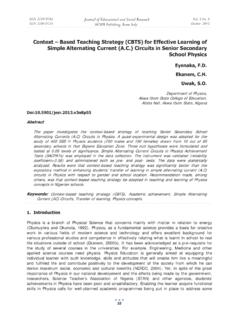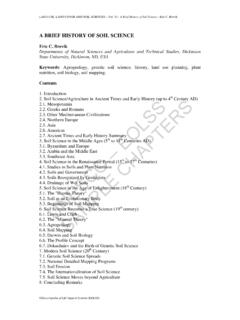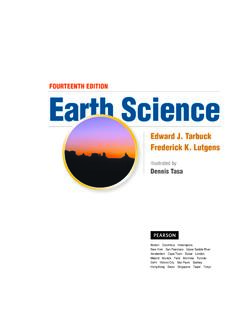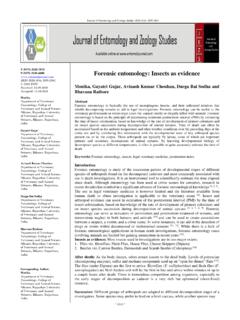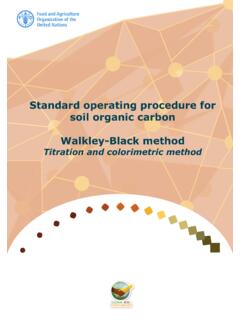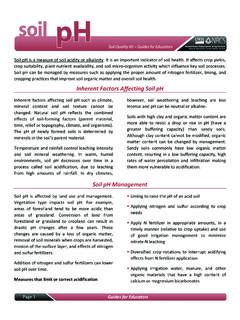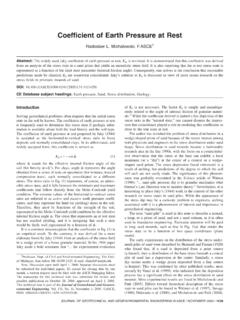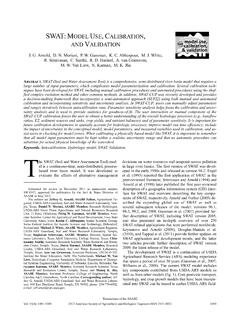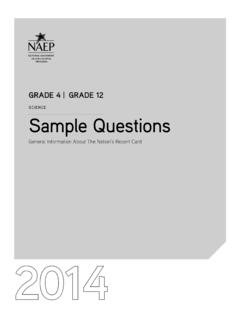Transcription of History & Development of Forensic Science
1 History & Development of Forensic Science Forensic Science Students will learn: How a crime lab works The growth and Development of Forensic Science through History Federal rules of evidence, including the Frye standard and the Daubert ruling Basic types of law in the criminal justice system Students will be able to: Describe how the scientific method is used to solve Forensic problems Describe different jobs done by Forensic scientists and the experts they consult. When in Forensic comes from the Latin word forensis meaning forum. During the time of the Romans, a criminal charge meant presenting the case before the public. Both the person accused of the crime & the accuser would give speeches based on their side of the story. The individual with the best argument would determine the outcome of the case. First Known Forensic Science 3rd Century China - A wife poisoned her husband and burned his body.
2 The coroner noted no ash inside his mouth and simulated the crime with dead & live pigs. The dead pig had no ash and the live pig did have ash in its mouth. The Wife confessed when shown the evidence. Chinese first to see potential in fingerprints. Murders at the Mansion August 20, 1989, Lyle Menendez, 21, & his brother Erik Menendez, 18, went out for the evening. When they returned, they found that their parents, Jose and Kitty, had been shot and killed in the living room. At 11:47 Lyle called 911. The police arrived shortly afterward. There was no evidence of forced entry, and nothing had been stolen from the home an indication Jose and Kitty likely knew their attackers. A witness told police she had seen two men enter the home at around 10:00 The brothers were questioned at the scene, but they were not considered suspects. No gunshot residue tests were administered.
3 August 28, the brothers began cashing in on their $650,000 life insurance policy. Jose and Kitty had owed money on their mortgage and several other loans. After those had been paid, the brothers were left with a total inheritance of approximately $2 million. By the end of the year, they had spent more than $1 million. This behavior drew suspicion from police. The brothers were arrested in March 1990. With little physical evidence, the investigators were hoping to find a link between the brothers and the guns used in the killings. Investigators searched the firearms records of a Big 5 store and uncovered the sale of two shotguns on August 18, 1989, to Donovan Goodreau of San Diego. Goodreau had an alibi for August 18 and August 20, and the signature for the firearms did not match his. A court order was issued for handwriting samples from Lyle and Erik.
4 Erik refused to provide a handwriting sample. On December 8, 1992, the Menendez brothers were indicted by the Los Angeles Grand Jury. The trial began on July 20, 1993. The defense admitted the brothers killed their parents; they argued that the brothers had been sexually, physically, and emotionally abused for years. Under California law, jurors had to believe the brothers feared for their lives in order to acquit them. The case resulted in a mistrial. A second trial in 1995 resulted in guilty verdicts for Lyle and Erik. They were convicted of first-degree murder and conspiracy to commit murder. On April 17, 1996, the brothers were sentenced to life in prison without the possibility of parole. Inheritance Killers - Erik & Lyle Menendez: Living next door to the killer Menendez brothers: Mathieu Orfila (1787-1853) Father of Toxicology Wrote about the detection of poisons & their effects on animals.
5 Alphonse Bertillon Father of Anthropometry Developed a system to distinguish one individual person from another based on certain body measurements. Anthropometry Francis Galton (1822-1911) Father of Fingerprinting Developed fingerprinting as a way to uniquely identify individuals. James Marsh Scottish Chemist First to introduce chemical evidence of arsenic in a body during a trial in 1839. Leone Lattes (1887-1954) Father of Bloodstain Identification He developed a procedure for determining the blood type (A, B, AB, or O) of a dried blood stain. Calvin Goddard (1891-1955) Father of Ballistics Developed the technique to examine bullets, using a comparison microscope, to determine whether or not a particular gun fired the bullets. Albert Osborn (1858-1946) Father of Document Examination His work led to the acceptance of documents as scientific evidence by the courts.
6 Walter McCrone (1916-2002) Father of Microscopic Forensics He developed & applied his microscope techniques to examine evidence in countless court cases. Edmond Locard (1877-1966) Used the scientific method in criminal investigation. Background was medicine and law. Father of criminalistics. Built the world s first forensics lab in France in 1910 The Locard Exchange Principle Locard Exchange Principle states: Whenever two objects come into contact with each other, there is always a transfer of material. J. Edgar Hoover Father of the FBI - Director of Federal Bureau of Investigation during the 1930 s Hoover's leadership spanned 48 yrs & 8 presidential administrations. His reign covered Prohibition, the Great Depression, WWII, the Korean War, the Cold War, & the Vietnam War. He organized a national laboratory to offer Forensic services to all law enforcement agencies in the VERY CONTROVERSIAL He exceeded & abused his authority with unjustified investigations & illegal wiretaps based on political beliefs rather than suspected criminal activity FBI directors are now limited to 10-year terms Sir Alec Jeffreys First to develop a DNA profile (DNA fingerprint) 1984 The Scientific Method Forensic Science begins at the crime scene.
7 Forensic scientists rely on the SCIENTIFIC METHOD. Scientific Method: is a series of logical steps used to solve a problem. Steps in the Scientific Method Identify the Problem: crime has been discovered & police arrive at the scene. Do Background Research: Observe and collect the physical evidence found at the crime scene. (done by the police & investigators) Construct Hypothesis: (police) hypothesis is an attempt to answer the following questions: what happened, how did it happen, and when did it happen? The crime-scene investigator does not form a hypothesis. Instead, he or she sends the evidence to the crime lab for further analysis. Establish a set of Procedures: send the physical evidence collected to the lab for testing. Ex. The hair removed from a crime scene is tested to reveal color, texture, and shape. Analyze results: If the toxicology report shows no use of drugs & there is no follicular tag (no nuclear DNA), it means that the hair will most-likely not be linked to anyone.
8 The tests can help investigators reduce the number of potential suspects. Draw conclusion: After all of the physical evidence has been processed and evaluated, a conclusion is drawn. If a suspect can be linked to a crime, then the suspect is apprehended. The Crime Scene Investigation (CSI) Team Team of legal and scientific experts who work together to process a crime scene and evaluate the evidence. Divided into a field investigative unit & crime lab scientists. The Crime Scene Investigation (CSI) Police officers are usually the first to arrive at the scene. They secure the scene and provide first aid to anyone who needs it. Crime-scene investigators record details about the crime scene and collect physical evidence. include photographers, sketch artists, and evidence collectors. Medical examiners are called in when there is a death.
9 Crime Labs Evidence collected at the scene is sent to the crime lab for analysis. Forensic scientists at the crime lab: specialize in fields such as chemistry, toxicology, pathology, and firearms. remain completely neutral in their analysis. do not form a hypothesis or draw conclusions about guilt or innocence. Information gathered from chemical and physical tests can be used: to establish a timeline of events. may corroborate a witness s statement. Poor communication: could lead to critical mistakes. Could put the entire process is in jeopardy. Ex, if the evidence is not collected properly, investigators in the crime lab may not make the correct analysis. PROCESSING A CRIME SCENE The first authorized personnel to arrive: must secure the scene, usually with crime-scene tape, move unauthorized people away from the area. Help someone in need of medical attention before doing anything else.
10 Detain and questioned people around the area (depending on the situation). Before any evidence is collected: Sketch & photograph the entire scene. Evidence must be left undisturbed in its original location. If circumstances warrant moving the evidence: ex. to tend to an injured victim, it must be noted in the records. Measurements of the crime scene and locations of items of evidence must be documented. After the crime scene and the evidence have been photographed, the field investigator will begin to collect and package the physical evidence. The size and location of a crime scene will determine the search method used: Zone building or other structure homicide, home invasion, robbery, sexual assault, etc. Spiral large area, no barriers open field kidnapping, homicide Line search large area looking for a large object in a single direction site of a plane crash Grid large area looking for a large object in two directions arson investigation EVIDENCE The analysis of physical evidence and the presentation of findings in court are the most powerful resources available to a prosecutor.
